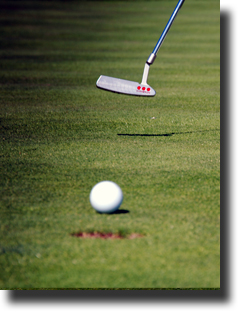

Skills needed to become a consistent putter: Distance Control • Center hit your putts. Find the sweet spot of your putter and hit it every time! This will give you the optimal energy transfer for all of your putts. It’s inconsistent and too hard to judge how far a ball will travel with variable, off center hits. • How far and how fast? How far is how long the putting stroke is and how fast is the speed at which the putter swings. Rhythm and timing are not only full swing keys but they are also very important to good putting. The best putters have great impact timing. I will define impact timing as the amount of time for the putter to swing in the backswing and return to the ball at impact. For example: for a short putt the stroke will be shorter and slower. For a longer putt, the stroke will lengthen and the speed of the putter will increase. That will allow the putter to return “on time.” Basically for both putts, the impact timing is the same even though the lengths of the putts are different. • Focus on learning to consistently roll the ball about a dollar bill length past the hole. The length of a dollar bill is approximately six inches, which is just longer than one complete revolution of a ball. If you become consistent with what the speed of the ball is rolling at the hole and how far your ball will travel past the hole, it will allow you to start truly reading the greens properly. Controlling the speed of your putts will piggyback onto how to read the greens coming up in a moment. Most three putts are caused by poor speed control of the first putt rather than from poor aim. Aiming • Most missed short putts are because of poorly aimed putter faces at address and specifically at impact. The aim of the putter face is dramatically more important than the exact path of the club. This being true it’s very interesting to watch the average person who practices on the practice green working on stroke mechanics more than simply practicing to aim the face correctly. I’m not saying that the stroke path has no influence on the short putts but learning to center hit a squarely aimed face is the key to consistently holing more short putts. • Buy a putter that fits you and allows you to aim the face more consistently. This does not always mean the putter that looks the best. Sometimes people like the way a center shafted, face balanced mallet looks or the way a heel-shafted, toe heavy blade looks, however, they can’t seem to aim them properly. Green Reading - slope, texture and speed • Reading the greens should start when approaching the green. Take in the general terrain of the golf course when approaching the hole. If there is a mountain on one side and a lake on the other side the ball will probably roll down towards the water. Nothing is ever 100%, but general rules when observing big slopes off the greens can help you determine which way your putts may “break” or curve. • Stand to the side and determine whether your putt is flat, uphill or downhill. This will help you determine how fast your putt will be and how hard you will need to hit the ball. • Uphill putts break less than downhill putts. This is because you need to hit the ball harder for up hill putts, therefore the ball will be rolling faster earlier in the putt and slow down quicker at the end of the putt. Downhill putts require a softer hit so the ball will generally roll slower to the hole and therefore curve more as the ball slows to the hole. When learning how to judge how much side slope there is in your putt, it is important to understand that the curve in the second half of the putt, closer to the hole, has more influence and importance for your putt. Of course you need to start your ball on line from the beginning and account for the total amount of curve. The ball will curve more at the end of the putt when the ball is rolling its slowest. This is important because sometimes the last few feet of your putt can turn right or left almost directly away from the hole and leave you outside your target of being inside a three foot circle. • Other factors to consider when learning to read greens: |
  |
